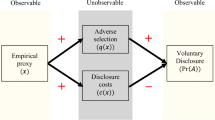Abstract
Thisstudy examines the welfare implications of a mandatory disclosurerequirement in an oligopolistic market, in which firms can choosetheir output either before or after the resolution of demanduncertainty. Two main results are derived. First, it is shownthat there exists a set of parameter values under which mandatorydisclosure is ineffective in the sense that it does not induceany change in the equilibrium production. Second, for some otherparameter values, imposing mandatory disclosure alters the firms'incentive structure in a way that gives rise to a Pareto lossin welfare; i.e., firms and consumers are made strictly worseoff. These two results suggest that the regulatory implicationsderived from the information-sharing literature should be interpretedwith caution.
Similar content being viewed by others
References
Barth, M., M. McNichols, and P. Wilson. (1997). “Factors Influencing Firms' Disclosures about Environmental Liabilities.” Review of Accounting Studies 2, 35–64.
Beaver, W.H. (1998). Financial Reporting: An Accounting Revolution (3rd edition). Englewood Cliffs: Prentice Hall.
Brander, J.A., and T.R. Lewis. (1986). “Oligopoly and Financial Structure: The Limited Liability Effect.” American Economic Review 76, 956–970.
Bryan, S.H. (1997). “Incremental Information Content of Required Disclosures Contained in Management Discussion and Analysis.” Accounting Review 72, 285–301.
Bulow, J.I., J.D. Geanakoplos, and P.D. Klemperer. (1985). “Multimarket Oligopoly: Strategic Substitutes and Complements.” Journal of Political Economy 93, 488–511.
Cason, T.N. (1994). “The Impact of Information Sharing Opportunities on Market Outcomes: An Experimental Study.” Southern Economic Journal 61, 18–39.
Chandra, U., A. Procassini, and G. Waymire. (1998). “The Use of Trade Association Disclosures by Investors and Analysts: Evidence from the Semiconductor Industry.” Working Paper, University of Iowa.
Clarke, R.N. (1983). “Collusion and the Incentives for Information Sharing.” Bell Journal of Economics 14, 383–394.
Clarkson, P.M., J.L. Kao, and G.D. Richardson. (1994). “The Voluntary Inclusion of Forecasts in the MD&A Section of Annual Reports.” Contemporary Accounting Research 11, 423–450.
Darrough, M. (1993). “Disclosure Policy and Competition: Cournot and Bertrand.” Accounting Review 68, 534–561.
Daughety, A.F., and J.F. Reinganum. (1994). “Asymmetric Information Acquisition and Behavior in Role Choice Models: An Endogenously Generated Signaling Game.” International Economic Review 35, 795–819.
Elliott, R.K., and P.D. Jacobson. (1994). “Costs and Benefits of Business Information Disclosure.” Accounting Horizons 8, 80–96.
Feltham, G.A., F.B. Gigler, and J.S. Hughes. (1992). “The Effects of Line-of-Business Reporting on Competition in Oligopoly Settings.” Contemporary Accounting Research 9, 1–23.
Gal-Or, E. (1985a). “First and Second Mover Advantages.” International Economic Review 26, 649–653.
Gal-Or, E. (1985b). “Information Sharing in Oligopoly.” Econometrica 53, 329–343.
Gal-Or, E. (1986). “Information Transmission—Cournot and Bertrand Equilibria.” Review of Economic Studies 53, 85–92.
Gal-Or, E. (1987). “First Mover's Disadvantages with Private Information.” Review of Economic Studies 54, 279–292.
Grossman, S. (1981). “The Informational Role of Warranties and Private Disclosure about Product Quality.” Journal of Law and Economics 24, 461–483.
Hughes, J.S., and J.L. Kao. (1991). “Economic Implications of Alternative Disclosure Rules for Research and Development Costs.” Contemporary Accounting Research 8, 152–169.
Hughes, J.S., and J.L. Kao. (1994). “Disclosure Rules and R&D Spending Revisited.” Contemporary Accounting Research 11, 633–646.
Hughes, J.S., J.L. Kao, and A. Mukherji. (1998). “Oligopoly, Financial Structure, and Resolution of Uncertainty.” Journal of Economics & Management Strategy 7, 67–88.
Hwang, Y., and A.J. Kirby. (2000). “Competitive Effects of Disclosure in a Strategic Entry Model.” Review of Accounting Studies 5, 57–85.
Jin, J.Y. (1996). “A Test for Information Sharing in Cournot Oligopoly.” Information Economics and Policy 8, 75–86.
Kao, J.L., and J.S. Hughes. (1993). “Note on Risk Aversion and Sharing of Firm Specific Information in Duopolies.” Journal of Industrial Economics 41, 103–112.
Li, L. (1985). “Cournot Oligopoly with Information Sharing.” Rand Journal of Economics 16, 521–536.
Mailath, G.J. (1993). “Endogenous Sequencing of Firm's Decision.” Journal of Economic Theory 59, 169–182.
Mautz, R.K., and W.G. May. (1978). Financial Disclosure in a Competitive Economy. New York, NY: Financial Executives Research Foundation.
Milgrom, P. (1981). “Good News and Bad News: Representation Theorems and Application.” Bell Journal of Economics 12, 380–391.
Novshek, W., and H. Sonnenshein. (1982). “Fulfilled Expectations Cournot Duopoly with Information Acquisition and Release.” Bell Journal of Economics 13, 214–218.
Ponssard, J. (1979). “The Strategic Role of Information on the Demand Function in an Oligopolistic Environment.” Management Science 25, 243–250.
Raith, M. (1996). “A General Model of Information Sharing in Oligopoly.” Journal of Economic Theory 71, 260–288.
Schelling, T. (1960). The Strategy of Conflict. Harvard University Press.
Shapiro, C. (1986). “Exchange of Cost Information in Oligopoly.” Review of Economic Studies 53, 433–446.
Spencer, B., and J. Brander. (1992). “Pre-commitment and Flexibility: Applications to Oligopoly Theory.” European Economic Review 36, 1601–1626.
Stevenson, R.B. (1980). Corporations and Information: Secrecy Access, and Disclosure. Baltimore, MD: The Johns Hopkins University Press.
U.S. Securities and Exchange Commission (SEC). (1989). Securities Act Release No. 6835.
Vives, X. (1984). “Duopoly Information Equilibrium: Cournot and Bertrand.” Journal of Economic Theory 34, 71–94.
Vives, X. (1990). “Trade Association Disclosure Rules, Incentives to Share Information, and Welfare.” Rand Journal of Economics 21, 409–430.
Watts, R.L., and J.L. Zimmerman. (1986). Positive Accounting Theory. Englewood Cliffs: Prentice-Hall.
Ziv, A. (1993). “Information Sharing in Oligopoly: The Truth Telling Problem.” Rand Journal of Economics 24, 455–464.
Author information
Authors and Affiliations
Rights and permissions
About this article
Cite this article
Pae, S. Information Sharing in the Presence of Preemptive Incentives: Economic Consequences of Mandatory Disclosure. Review of Accounting Studies 5, 331–350 (2000). https://doi.org/10.1023/A:1026597606819
Issue Date:
DOI: https://doi.org/10.1023/A:1026597606819




